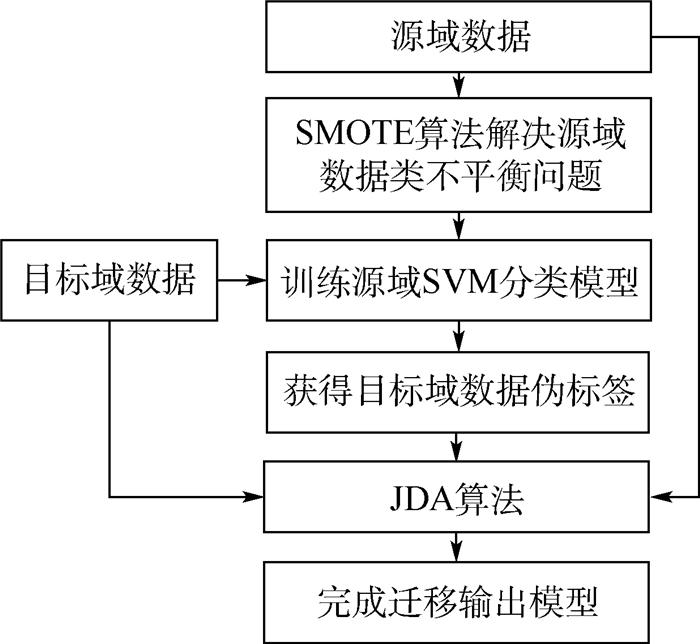Operating status evaluation of smart electricity meters based on joint distribution adaption
-
摘要:
针对智能电表运行状态评价中经常存在带标签的数据采集困难且不同地区的数据分布不一致的问题,在智能电表的运行状态评价领域引入迁移学习中的联合分布适配(JDA)算法。该算法寻找一个最优化的变换矩阵,使得在变换后的空间中不同地区数据的边缘分布和条件分布距离最小化。针对条件分布适配中目标域没有数据标签的问题,采用伪标签迭代的方法使得目标域伪标签不断接近真实标签。变换后空间数据中训练得到的分类模型可以运用于新的地区,实现迁移。实验结果证明了JDA算法在智能电表运行状态评价中的有效性。
-
关键词:
- 联合分布适配(JDA) /
- 智能电表 /
- 运行状态评价 /
- 迁移学习 /
- 智能电网
Abstract:In the operation status evaluation of smart electricity meters, it is often difficult to collect labeled data and the data distribution in different regions is inconsistent. To solve this problem, we introduce the joint distribution adaption (JDA) method in transfer learning in the field of operation status evaluation of smart electricity meters. This method tries to find an optimized transformation matrix to minimize the distance between edge distribution and conditional distribution in different regions in the transformed space. In order to solve the problem that there is no data label in the target domain when the conditional distribution adaptation is made, the JDA method uses pseudo-tag iteration method to make the target domain pseudo-label constantly approach the real tag. The classification model trained from the data in the post-transformation space can be applied to the new region to realize the transfer. The experimental results demonstrate the effectiveness of JDA method in the operation status evaluation of smart electricity meters.
-
表 1 福建省电表数据集
Table 1. Dataset of electricity meters in Fujian province
属性 取值范围 有功准确度等级 0.5S, 1.0, 2.0 额定负载点误差测量 -0.054~0.25 最小负载点误差测量 -0.249~0.25 最大负载点误差测量 -0.265~0.25 第一次运行误差测量 0.05~0.4 第二次运行误差测量 0~0.45 第三次运行误差测量 0~0.5 运行时间 0~6.5 运行环境 1, 1.2, 2 家族缺陷 1 电量异常次数 0 时钟异常次数 0~7 运行等级 1, 2, 3 表 2 福建省电表等级分布
Table 2. Grade distribution of electricity meters in Fujian province
运行等级 数量 占比/% 1 13 2.56 2 418 82.44 3 76 15.00 表 3 基于SMOTE算法不平衡数据处理后的福建省数据分布
Table 3. Data distribution of Fujian province after imbalanced data processing based on SMOTE algorithm
运行等级 数量 占比/% 1 391 35.26 2 418 37.69 3 300 27.05 合计 1 109 100.00 表 4 目标域数据初始伪标签分布
Table 4. Initial pseudo-label distribution of target domain data
运行等级 数量 占比/% 1 49 8.13 2 369 61.19 3 185 30.68 合计 603 100.00 表 5 迁移后模型的混淆矩阵
Table 5. Confusion matrix of transferred model
混淆矩阵 预测类1 预测类2 预测类3 真实类 1 39 3 0 真实类 2 10 364 0 真实类 3 0 2 185 表 6 迁移后模型的主要评价指标
Table 6. Main evaluation indicators of transferred model
评价指标 结果 准确度 0.975 F1分数 0.943 -
[1] 陈文娴. 基于深度学习的小样本异常用电数据检测技术研究[D]. 武汉: 华中科技大学, 2018.CHEN W X. Abnormal electricity utilization detection based on deep learning and few-shot learning[D]. Wuhan: Huazhong University of Science and Technology, 2018(in Chinese). [2] 商曦文, 张颖, 吉莹, 等. 智能电表运行状态评估技术研究[J]. 自动化与仪器仪表, 2018, 11(3): 139-146.SHANG X W, ZHANG Y, JI Y, et. al. Research on smart meters' running state assessment techniques[J]. Automation & Instrumentation, 2018, 11(3): 139-146(in Chinese). [3] CAI H, CHEN H Q, YE X Q, et al. An on-line state evaluation method of smart meters based on information fusion[J]. IEEE Access, 2019, 1(7): 163665-163676. [4] LI Y F, WU H, PANG S, et al. Application of supervised machine learning algorithms in diagnosis of abnormal voltage[J]. Electrical Measurement and Instrumentation, 2016, 53(1): 58-62. [5] 叶剑斌, 朱东升, 汪翊节, 等. 智能电能表状态检验技术研究[J]. 自动化仪表, 2020, 41(1): 55-59. https://www.cnki.com.cn/Article/CJFDTOTAL-ZDYB202001010.htmYE J B, ZHU D S, WANG Y J, et al. Research on intelligent electric energy meter state inspection technology[J]. Process Aotumation Instrumentation, 2020, 41(1): 55-59(in Chinese). https://www.cnki.com.cn/Article/CJFDTOTAL-ZDYB202001010.htm [6] 祝宇楠, 徐晴, 刘建, 等. 数据挖掘在智能电能表故障分析中的应用[J]. 电力工程技术, 2016, 35(5): 19-23. doi: 10.3969/j.issn.1009-0665.2016.05.005ZHU Y N, XU Q, LIU J, et al. Application of data mining in fault analysis of intelligent electricity meters[J]. Power Engineering Technology, 2016, 35(5): 19-23(in Chinese). doi: 10.3969/j.issn.1009-0665.2016.05.005 [7] 韩笑. 基于不确定性信息融合的智能电能表状态评价方法研究[D]. 长春: 吉林大学, 2018: 22-58.HAN X. Research on state evaluation method of smart electricity meter based on uncertainty information fusion[D]. Changchun: Jilin University, 2018: 22-58(in Chinese). [8] CHENG Y Y, HOU X Z, XIAO J. Design and realization of condition management system of gateway electrical[J]. Electrical Measurement and Instrumentation, 2013, 50(8): 87-92. [9] SHEN X, ZHAO D N, CAO M. Research on energy metering device remote online monitoring and analysis platform based on internet of thing[J]. Electrical Measurement and Instrumentation, 2015, 52(1): 35-40. [10] 王新刚, 吴颖, 张垠. 基于数据挖掘的智能电能表在线监测方法[J]. 电测与仪表, 2016, 53(13): 65-69. doi: 10.3969/j.issn.1001-1390.2016.13.013WANG X G, WU Y, ZHANG Y. Online monitoring method of intelligent electricity meters based on data mining[J]. Electric Measurement and Instrumentation, 2016, 53(13): 65-69(in Chinese). doi: 10.3969/j.issn.1001-1390.2016.13.013 [11] LONG M S, WANG J, DING G, et al. Transfer feature learning with joint distribution adaptation[C]//2013 IEEE International Conference on Computer Vision. Piscataway: IEEE Press, 2013: 1-8. [12] CHAWLA N V, BOWYER K W, HALL L O, et al. SMOTE: Synthetic minority over-sampling technique[J]. Journal of Artificial Intelligence Research, 2011, 16(1): 321-357. [13] BORGWARDT K M, GRETTON A, RASCH M J, et al. Integrating structured biological data by kernel maximum mean discrepancy[J]. Bioinformatics, 2006, 22(14): 49-57. doi: 10.1093/bioinformatics/btl242 [14] FILISBINO T A, GIRALDI G A, THOMAZ C E. Support vector machine ensembles for discriminant analysis for ranking principal components[J]. Multimedia Tools and Applications, 2020, 79(5): 1-37. [15] PAN S J, TSANG I W, KWOK J T, et al. Domain adaptation via transfer component analysis[J]. IEEE Transactions on Neural Networks, 2011, 22(2): 199-210. doi: 10.1109/TNN.2010.2091281 [16] GRETTON A, BORGWARDT K M, RASCH M J, et al. A kernel method for the two-sample problem[J]. Neural Information Processing Systems, 2006, 4(3): 1-10. [17] FAN J, KE Z T, LIU H, et al. QUADRO: A supervised dimension reduction method via Rayleigh quotient optimization[J]. Annals of Statistics, 2015, 4(43): 1498-1534. [18] 龙明盛. 迁移学习问题与方法研究[D]. 北京: 清华大学, 2014.LONG M S. Research on transfer learning problems and methods[D]. Beijing: Tsinghua University, 2014(in Chinese). -







 下载:
下载:





